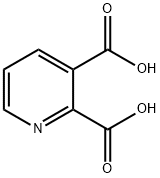yihekeji@chembuying.com
86-18427358861

| Product Name: | Quinolinic acid |
| Synonyms: | 2,3-PyridinedicarboxylicAcid99%;QuinolinicAcid>99%;Pyridin-2,3-dicarbonsaeure;2,3-Pyridinedicarboxylic;2,3-PYRIDINEDICARBOXYLIC ACID (QUINOLINIC ACID);2,3-pyridine dicarbo;2,3-PYRIDINEDICARBOXYLIC ACID;AKOS BBS-00003814 |
| CAS: | 89-00-9 |
| MF: | C7H5NO4 |
| MW: | 167.12 |
| EINECS: | 201-874-8 |
| Product Categories: | Pyridine series;Pyridine;pyridine derivative;Carboxylic Acids;Pyridines;Heterocyclic Compounds;Medical Intermediates;Heterocycles;Inhibitors;Carboxylic Acids;Aromatics;Intermediates & Fine Chemicals;Pharmaceuticals;Pesticides intermediate;Pyrimidines |
| Mol File: | 89-00-9.mol |

|
|
| Quinolinic acid Chemical Properties |
| Melting point | 188-190 °C (dec.) (lit.) |
| Boiling point | 295.67°C (rough estimate) |
| density | 1.5216 (rough estimate) |
| refractive index | 1.6280 (estimate) |
| storage temp. | Keep in dark place,Sealed in dry,Room Temperature |
| solubility | 10g/l |
| pka | 2.43(at 25℃) |
| form | Crystalline Powder |
| color | White to light yellow-beige |
| Odor | odorless |
| Water Solubility | 0.55 g/100 mL |
| Merck | 14,8073 |
| BRN | 137110 |
| InChIKey | GJAWHXHKYYXBSV-UHFFFAOYSA-N |
| CAS DataBase Reference | 89-00-9(CAS DataBase Reference) |
| EPA Substance Registry System | 2,3-Pyridinedicarboxylic acid (89-00-9) |
| Safety Information |
| Hazard Codes | Xi |
| Risk Statements | 36/37/38-33 |
| Safety Statements | 26-36/37-24/25-37 |
| WGK Germany | 3 |
| RTECS | US7967250 |
| TSCA | T |
| HazardClass | IRRITANT |
| HS Code | 29333999 |
| Hazardous Substances Data | 89-00-9(Hazardous Substances Data) |
| Toxicity | Focal injection of quinolinic acid into specific areas of the brain produces neuronal damage although sparing axons of passage. Similarities between the biochemical and morphological profiles of these lesions and human neuropathy seen in neurodegenerative diseases have led to the proposal that endogenous excitotoxins may play a role in such neurodegenerative disease states. Quinolinic acid is an intermediate in the kynurenine pathway of tryptophan metabolism and has been detected in the brains of several mammals including man. The neuroexcitatory action is thought to be mediated via interaction with the N-methyl-D-aspartate (NMDA) receptor of the glutamate family. No mechanism for quinolinic acid removal, nor for synaptic inactivation, has been found, and consequently accumulation of concentrations capa_x0002_ble of inducing neuronal degeneration and death may occur. |
Name: Eric Yuan
Mobile:86-18427358861
Tel:86-18427358861
Whatsapp:+86 18427358861
Email:yihekeji@chembuying.com
Add: